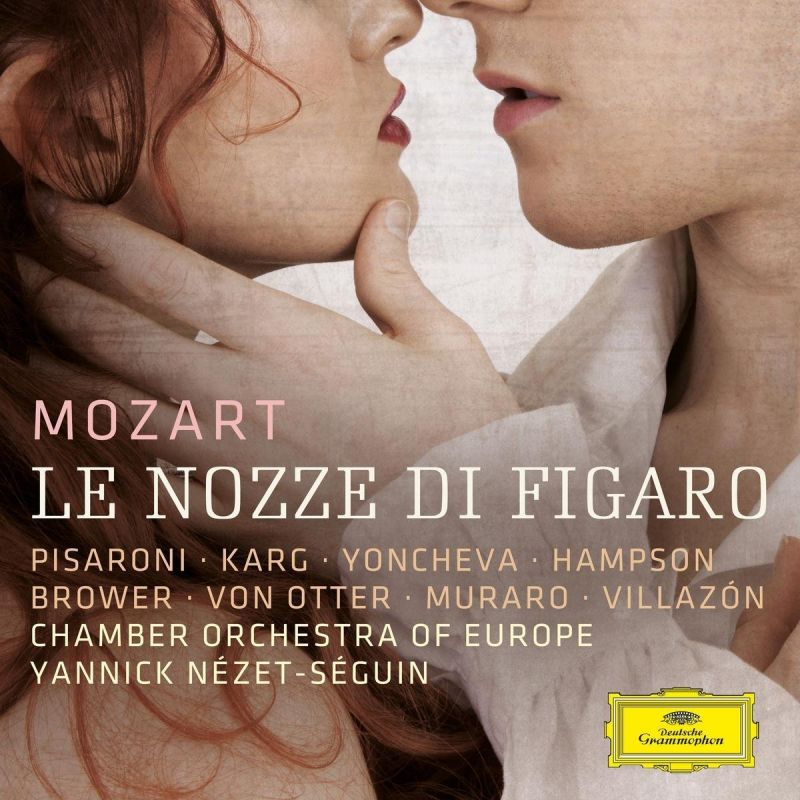MOZART Le nozze di Figaro
View record and artist detailsRecord and Artist Details
Composer or Director: Wolfgang Amadeus Mozart
Genre:
Opera
Label: Deutsche Grammophon
Magazine Review Date: 09/2016
Media Format: CD or Download
Media Runtime: 174
Mastering:
DDD
Catalogue Number: 479 5945GH3

Tracks:
| Composition | Artist Credit |
|---|---|
| (Le) nozze di Figaro, '(The) Marriage of Figaro' |
Wolfgang Amadeus Mozart, Composer
Angela Brower, Cherubino, Mezzo soprano Anne Sofie von Otter, Marcellina, Mezzo soprano Chamber Orchestra of Europe Christiane Karg, Susanna, Soprano Jean-Paul Fouchécourt, Don Curzio, Tenor Luca Pisaroni, Figaro, Bass-baritone Maurizio Muraro, Bartolo, Bass Philippe Sly, Antonio, Bass-baritone Rastatt Vocal Ensemble Regula Mühlemann, Barbarina, Soprano Rolando Villazón, Don Basilio, Tenor Sonya Yoncheva, Countess Almaviva, Soprano Thomas Hampson, Count Almaviva, Baritone Wolfgang Amadeus Mozart, Composer Yannick Nézet-Séguin, Conductor |
Author: Richard Lawrence
The cast is led by Luca Pisaroni and Christiane Karg. Pisaroni’s dark-toned Figaro is dangerous in ‘Se vuol ballare’, bitter in ‘Aprite un po’ quelgi occhi’. The dotted rhythm of ‘Non più andrai’ is foot-tappingly crisp and his pacing of the recitative when plotting with Susanna and the Countess is exemplary. As Susanna, Karg moves effortlessly from the spirited girl of Act 1 – there’s some delightfully playful decoration to the last phrases of the second duet – to a tender, womanly account of ‘Deh vieni’. She blends perfectly with the Countess in the Letter Duet. Unlike her colleagues, Sonya Yoncheva doesn’t ornament her arias, not even essaying a lead-in to the reprise of ‘Dove sono’; but her open-throated singing is glorious. Interestingly, she doesn’t display the usual irritation with Susanna in the dressing-up scene. Thomas Hampson, though, gets quite violent towards Cherubino. He makes an authoritative Count but tends to sing sharp when being forceful. Angela Brower, a soprano-sounding mezzo, is a spirited, coltish Cherubino.
If you must cast a mezzo as Marcellina, omit the Act 4 aria. If you must include the aria, cast a soprano. It’s as simple as that; but the conductor casts a mezzo and includes the aria, so ‘Il capro e la capretta’ is transposed down by a minor third. Anne Sofie von Otter is fine elsewhere and she is well partnered by the formidable Bartolo of Maurizio Muraro. Rolando Villazón is amusingly camp in Basilio’s recitatives, and he crowns ‘In quegli anni’ with a ringing top B flat.
The traditional order of Act 3 is retained, the trial scene preceding ‘Dove sono’. As mentioned, there are some (nicely done) embellishments; appoggiaturas, too, though there’s a crucial one missing when the Count echoes ‘Poverino!’ in the Act 1 trio. Also missing is the slap in the Recognition Sextet. No applause; quiet laughter here and there. Not a vintage performance, then, but a more than acceptable addition to the series.
Discover the world's largest classical music catalogue with Presto Music.

Gramophone Digital Club
- Digital Edition
- Digital Archive
- Reviews Database
- Full website access
From £8.75 / month
Subscribe
Gramophone Full Club
- Print Edition
- Digital Edition
- Digital Archive
- Reviews Database
- Full website access
From £11.00 / month
Subscribe
If you are a library, university or other organisation that would be interested in an institutional subscription to Gramophone please click here for further information.




